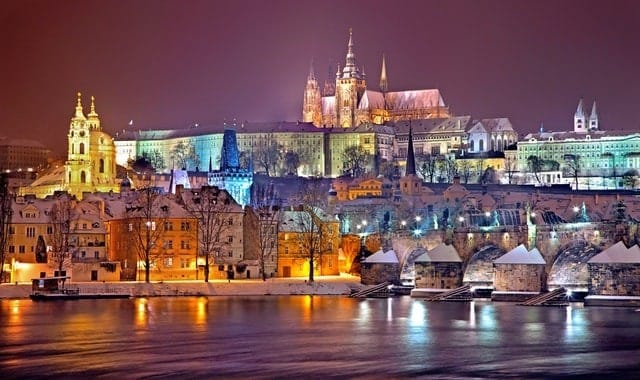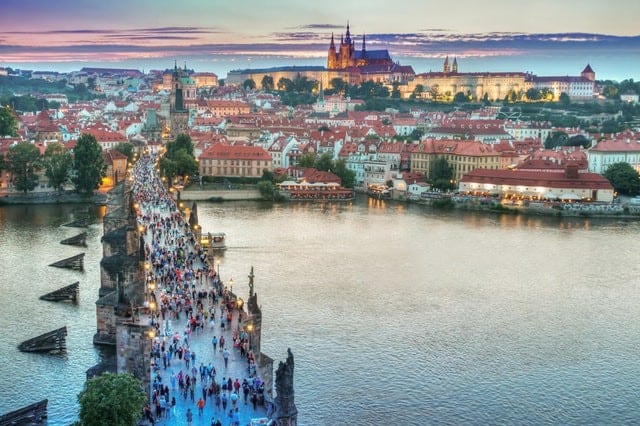The essential of historical Prague in just 48 hours
The historical centre of Prague is a compact area which – provided you have a good itinerary – can be reasonably visited in just two days without missing out any of the essential sights or the general image of the city in the past and nowadays. The early medieval town started to develop along both sides of the Moldau (Vltava) river, upon and underneath several hills that provided the necessary visual safety point. The settlement has naturally copied this geographical situation. Even if you have only one day in Prague, you can be lead by our two day itinerary and just make everything a bit faster…
Vltava river banks
The left bank created by two hills mirroring the river was the best ground in terms of protection. This is why the Czech princess chose to build their seat here, on the premises where the Prague castle as well as the archbishopric and other important residencies stand till presence. The opposite right bank lacked any natural protective area, just in the contrary: it was endangered not only by people, but mainly by the river. Being flat, this area was flooded each time a bigger water appeared, and therefore considered as unfavourable.
This medieval division of the city is apparent till our days, long after the settlers managed to regulate (till a certain mesure) the water flow. And it gives us also a clear way how to divide our itinerary- spending each of the days on the different Vltava banks.
Day one in Prague
Above the castle
Day one should be dedicated to the visit of the Castle and neighbouring historical parts. The best place to start the visit is the Strahov monastery – a premonstratensian foundation above the hills built at the gates of the castle to protect it. It is recommended to use the iconic tram number 22 (which is one of the most frequent links Prague public transport offers, so no worries about losing your time) to get to the station Pohořelec. Strahov monastery sets up before your eyes at the moment you leave the tram and is worth a detailed visit: it offers one of the best decorated baroque libraries, an important art gallery as well as an exposition of bizarre objects gathered by one of the renaissance abbots. Before leaving the monastery premises, do not miss a beautiful view terrace to get a basic notion about the city – the historic parts and the modern areas along the horizon.
Hradčany
Your steps can be then easily led by your eyes, as the Prague Castle is in sight. Prague Castle is said to be the largest castle complex in the world, but in the true sense of the word, the complex covered much larger function then the seat of the prince or king: it contains several religious foundations, several noble palaces and so on. Being the most important sight of the country, the visit should include some inner spaces as well as galleries and might take half a day.
Lesser Town
Once you leave the Castle, you will find yourself in the quartier called Lesser town, populated since the Middle ages by noble families that wanted to be close to the Castle. That is why you will find here mostly large palaces in baroque style. The largest premises belonged to the 30 years war warrior Albrecht z Valdštejna and present a fine example of the 17th century baroque in Bohemia. Somewhere around the streets of Lesser Town, you first day should end.
Day two in Prague

The second day shall be dedicated to the right bank of Vltava river – The Old town and the Jewish town of Prague.
The Old Town Of Prague
As already mentioned, this area was considered as less favourable due to many facts, and therefore the professions and vocations considered as inferior were allowed to settle here: first of all, it was a large market dedicated for merchants: those coming from the distant countries had to stay for a few day in the fenced court called Týn (-which means fenced off) – to protect the city from the possible infections. Some of the merchants settled here – there is a clear evidence of early medieval French or German settlements adjoining to the Týn court and the Old Town square. That is why you will not find any great palaces, jsut smaller and modest city houses when strolling through the streets of the Old Town. Just as the famous building decorated in neo-renaissance style V.J. Rott – converted into a stylish Old Town hotel Rott. And for the midday – and midway – is great to make a lunch break in the great restaurant situated just in this centre al spot between the Old Town and the Jewish town – Nuance restaurant.
The Jewish Town
The area that was mostly endangered by the river and therefore of no use was left for Jews: the first mention of Prague itself and its market dates back to the years 965 or 966 and was written by a Jewish merchant from Andalusia, a certain Inrahim Ibn Jacob. The Jews started settling in the bend of Vltava river before the beginning of the second millenium and their settlement lasted – with small exemptions as such within the reign of Maria Theresia – till WWII.
That is why Prague has one of the oldest, most complex and preserved Jewish towns in the world, together with the oldest functioning synagogue, the Old New synagogue. Spare at least two hours for a visit of this unique place creating the history of the Jewish nation in the last millenium.
The New Town
Your visit should finish somewhere around Wenceslas Square – where the New Town of Prague begins. New in opposite to the Old town, altough the new town was founded by Charles IV with a plan to provide appropriate housing and workspace for the growing city of Prague. Wenceslas square is the modern centre of the city and therefore a place that should not be missed as it depicts the architecctural history of the city since the 19th century.
